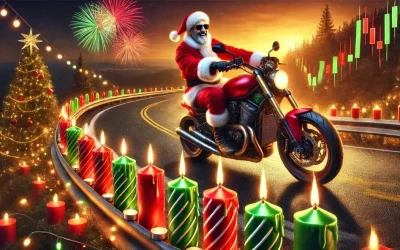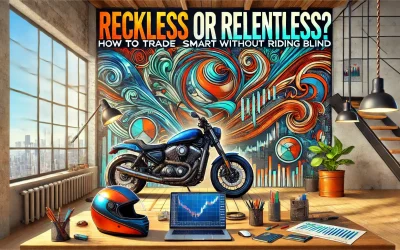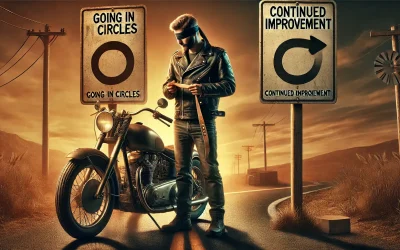Trade Exit Automation Pt 2 – Einstein Edition. Advanced Features.
If you missed part 1, please see HERE.
Notes:
Hi all,
In this video, we’ll continue to discuss trade exit strategies and we start with a variation of the multi-leg strategy discussed in part 1.
Multi-Leg Strategy
We tweaked the strategy by removing the trail option from it.
Having multiple stop orders, not being trailed automatically, for active traders, the ability to manually adjust those orders individually can be of the utmost importance for their trade management, especially when trading slower markets.
When trading faster markets though, trailing orders can be more effective in protecting our position from fast reversal moves.
We place our buy order, it gets executed, and now, we have not only 4 targets but also 4 stop orders.
Our first target gets executed, and we adjust one of the stop orders manually by clicking on the price where the order is and then clicking again at the entry price so that the order is moved to it. We have now one of our stops at breakeven.
We have still 2 stop orders down below that we should adjust, and instead of clicking on each order manually, we have a cool feature which is the S2P or (stop 2 price) and L2P (limit 2 price) buttons in the trade window, and what they do when activated is moved all orders we have, stop or limit, to one single price at the same time when we click on it.
The second target is executed, our breakeven stop is canceled, and we now adjust our last two stops also to breakeven.
We activate the S2P button, and when we click at our entry price, at 72 evens, see how both stop orders move to that price at the same time.
The market continues to move in our way, executing our last target.
StopLimit Strategy
In this next example, we’ll be looking at a stoplimit strategy.
We changed the stop type to a stoplimit order and enabled the offset option by setting it up to 3 ticks.
We place our sell order, and it gets executed.
Our stop limit order is placed at 65.50, prices start to go against us and our order gets executed.
Volume Stop Strategy
Let’s now talk about volume stop strategies.
In this example, we have enabled the volume stop option by setting it up to 20 lots.
We place our buy order, it gets executed, and our volume stop is placed at 02.50, where we have 106 lots waiting to be executed.
For this order to be triggered 2 things need to happen. 1st we need the market to trade the 02.50 as the inside bid and 2nd that bid needs to be equal to or lower than 20 lots, which means if that bid at 02.50 never drops below 21 lots while trading as the inside bid, that volume stop will never trigger.
In this case, as the market comes against our position, as the bid gets cleared, our volume stop triggers, becoming a market order and getting executed at the first available price.
Add to Position Strategy
In the last example, we’ll show how we can add a strategy, or more legs, to our position.
The strategy used is very similar to our multi-leg strategy, in fact, the only difference is the number of legs and the quantity traded.
We place our sell order which is executed. We sold 2 lots, which is the default quantity of our strategy.
We have our initial 2 stop orders and 2 targets.
The third leg of the strategy has an asterisk set as the quantity. This will allow us to add more legs to our position as we scale in. The quantity used will be the one set on the trade window, which will be 2 lots.
As the market moves our way, we add to our position by selling 2 more lots and notice how we just added a third stop order and target.
Our first target gets executed, we sell another 2 lots, another stop, and target are added, and since we have the S2P button enabled, when we clicked on the 25 evens price, all 3 stop orders move automatically to it.
We then have our second target executed and a couple of minutes later our third and fourth targets get executed also closing this way our position.
Summary
In summary, our strategies are very simple and straightforward. Our goal is always to offer tools that are simple to work with and with only the essential options available.
FREE BONUS: Take a look into the decision-making process of professional traders with this video training series that helps you make smarter trading decisions. (Article continues below)
Order Flow itself is simply information. Just like charts, it can be used in a number of ways, some good and some bad. But let's first break down order flow into it's components so we all agree what we are talking about:
Order Executions/Tape Reading - This aspect is the real flow of orders. It's the information we see in Time & Sales, Footprint Charts, Cumulative Delta. It is looking at market orders, either as they execute or historically. I guess this is the "true order flow". Every trade is a buy and a sell. We look at market orders because we consider them to be more aggressive. When someone trades with a market orders, they are giving up a price to get an instant fill. Limit orders on the other hand just lazily sit there waiting for a market order to hit them. Often these are market makers with no directional conviction. So we see market orders as being more significant.
But we don't use these in isolation.
Volume Profile/Positions - The tape reading part helps us assess various things like momentum, traders getting stuck, balance of trade BUT the volume profile helps us understand where people are positioned and likely to get stopped out. I sometimes call this "Order Flew". It's important to know when trades will be "washed out" - for example - if we have a volume cluster on the S&P500 Futures and the market moves up 100 points and back down to it, it's unlikely short term traders on either side that were positioned there will still be there. But recent, nearby volume helps us assess areas of positions.
Market Depth - The bids and offers, the lazy passive orders waiting to be hit. This is part of the story but in terms of overall importance, I'd put it at around 20% at most. For example - if you return to the high of the day on any market, the offers will be quite large directly above the high. It means nothing at all. It's just a quirk of the market. It does not help you tell if a price will hold. On the other hand, if you see large depth and as we approach it, we see more added to the depth in front of that price, it means others are front running that depth and that is a useful bit of information.
This is the key - it is all just information. Just like price charts are information. When people look at Order Flow, they consider it to be a technique more than a set of information. They look for things like iceberg orders and decide to make a one rule trading system to fade every iceberg, For these people - yes, order flow is overrated because they are trying to ignore everything else going on in the markets and construct a trading system a chimp could execute.
For those looking to improve a decent trading approach, the best thing to focus on in Order Flow is momentum. Once you can read momentum you can:
- Avoid getting into positions when momentum is against you.
- Confirm trades are working after entry when momentum goes your way.
- Exit trades in profit when momentum fades.
That's perhaps the easiest way to use order flow because momentum is easier to read. It's about the market continuing to do what it's already doing. On the other hand, reading a turn in the market with order flow takes a higher level of skill and a little longer to learn.
Order flow can't put lipstick on a pig. It won't help you 'improve' something that doesn't work anyway, which is why whenever someone calls me, the first thing I ask is what they are currently doing and we discuss whether they need a reset or whether it will actually help.
When Jigsaw started back in 2011 - we were one of the first in the space and certainly had the best education. It was always going to attract the underbelly of the trading education/tools world and now we see stuff out there that is so complex but so impressive and futuristic that new traders are drawn to it like moths to a flame.
So here's my advice when looking at Order Flow
- Order Flow can't improve something that doesn't work.
- Order Flow can be used on it's own, without charts to enter and exit the market but you also have to be able to recognize different market states that need different/altered setups. There is nothing magical about this.
- Don't start jumping at shadows and take 50 trades an hour in your first week looking at Order Flow, be selective. It can be exciting to see cause and effect play out in front of you for the first time but don't overtrade.
- Do drills to learn how to read it before you trade it.
- Markets can only go up and down. Don't overcomplicate it. If you have too many Order Flow tools on your screen - you will not be able to make consistent decisions. Less is more.
- Take time to choose a market with a pace you like. Interest rates might send you to sleep, the DAX might give you a heart attack.
It is hard to see how a set of information could be overrated. It is true that some methods of presenting this information are better than others. It is also true that some people simply get on better with different tools (e.g. Footprint vs DOM).
There's a middle ground between complexity and simplicity that will leave you making consistent decisions where you improve over time. For those people, Order Flow will be way underrated because they will be the one's getting the most out of it.
Those that jump in with both feet on day one and those that have 100 different tools up, for those, it's a painful experience.
Keep it simple and manageable. Start with momentum reading and build from there. You will never look back.




0 Comments